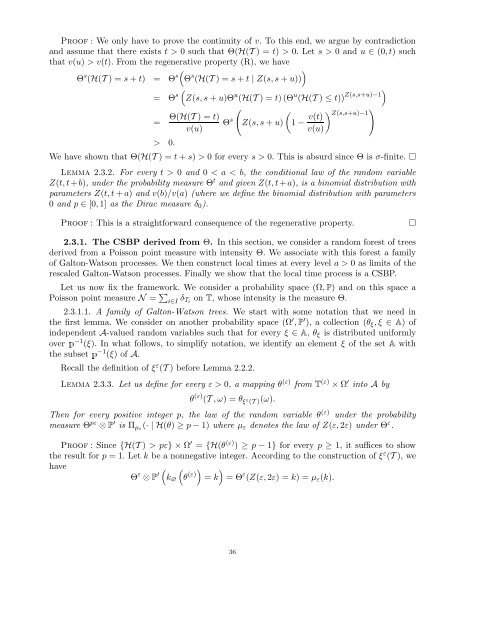arbres aléatoires, conditionnement et cartes planaires - DMA - Ens
arbres aléatoires, conditionnement et cartes planaires - DMA - Ens
arbres aléatoires, conditionnement et cartes planaires - DMA - Ens
You also want an ePaper? Increase the reach of your titles
YUMPU automatically turns print PDFs into web optimized ePapers that Google loves.
Proof : We only have to prove the continuity of v. To this end, we argue by contradiction<br />
and assume that there exists t > 0 such that Θ(H(T ) = t) > 0. L<strong>et</strong> s > 0 and u ∈ (0,t) such<br />
that v(u) > v(t). From the regenerative property (R), we have<br />
Θ s (H(T ) = s + t) = Θ s( )<br />
Θ s (H(T ) = s + t | Z(s,s + u))<br />
= Θ s ( Z(s,s + u)Θ u (H(T ) = t)(Θ u (H(T ) ≤ t)) Z(s,s+u)−1)<br />
=<br />
> 0.<br />
Θ(H(T ) = t)<br />
v(u)<br />
(<br />
Θ<br />
(Z(s,s s + u) 1 − v(t) ) )<br />
Z(s,s+u)−1<br />
v(u)<br />
We have shown that Θ(H(T ) = t + s) > 0 for every s > 0. This is absurd since Θ is σ-finite. □<br />
Lemma 2.3.2. For every t > 0 and 0 < a < b, the conditional law of the random variable<br />
Z(t,t+b), under the probability measure Θ t and given Z(t,t+a), is a binomial distribution with<br />
param<strong>et</strong>ers Z(t,t+a) and v(b)/v(a) (where we define the binomial distribution with param<strong>et</strong>ers<br />
0 and p ∈ [0,1] as the Dirac measure δ 0 ).<br />
Proof : This is a straightforward consequence of the regenerative property.<br />
□<br />
2.3.1. The CSBP derived from Θ. In this section, we consider a random forest of trees<br />
derived from a Poisson point measure with intensity Θ. We associate with this forest a family<br />
of Galton-Watson processes. We then construct local times at every level a > 0 as limits of the<br />
rescaled Galton-Watson processes. Finally we show that the local time process is a CSBP.<br />
L<strong>et</strong> us now fix the framework. We consider a probability space (Ω, P) and on this space a<br />
Poisson point measure N = ∑ i∈I δ T i<br />
on T, whose intensity is the measure Θ.<br />
2.3.1.1. A family of Galton-Watson trees. We start with some notation that we need in<br />
the first lemma. We consider on another probability space (Ω ′ , P ′ ), a collection (θ ξ ,ξ ∈ A) of<br />
independent A-valued random variables such that for every ξ ∈ A, θ ξ is distributed uniformly<br />
overÔ−1 (ξ). In what follows, to simplify notation, we identify an element ξ of the s<strong>et</strong> A with<br />
the subs<strong>et</strong>Ô−1 (ξ) of A.<br />
Recall the definition of ξ ε (T ) before Lemma 2.2.2.<br />
Lemma 2.3.3. L<strong>et</strong> us define for every ε > 0, a mapping θ (ε) from T (ε) × Ω ′ into A by<br />
θ (ε) (T ,ω) = θ ξ ε (T )(ω).<br />
Then for every positive integer p, the law of the random variable θ (ε) under the probability<br />
measure Θ pε ⊗ P ′ is Π µε (· | H(θ) ≥ p − 1) where µ ε denotes the law of Z(ε,2ε) under Θ ε .<br />
Proof : Since {H(T ) > pε} × Ω ′ = {H(θ (ε) ) ≥ p − 1} for every p ≥ 1, it suffices to show<br />
the result for p = 1. L<strong>et</strong> k be a nonnegative integer. According to the construction of ξ ε (T ), we<br />
have<br />
( Θ ε ⊗ P ′ k ∅<br />
(θ (ε)) )<br />
= k = Θ ε (Z(ε,2ε) = k) = µ ε (k).<br />
36

















